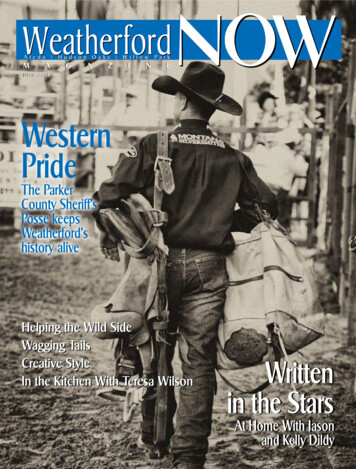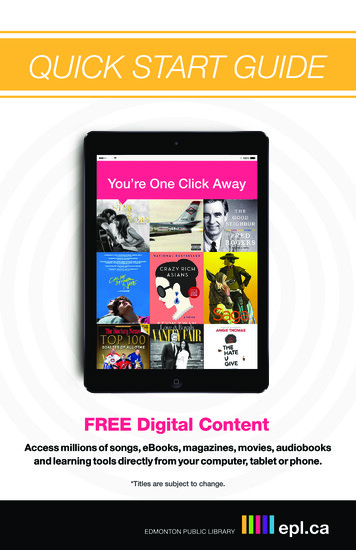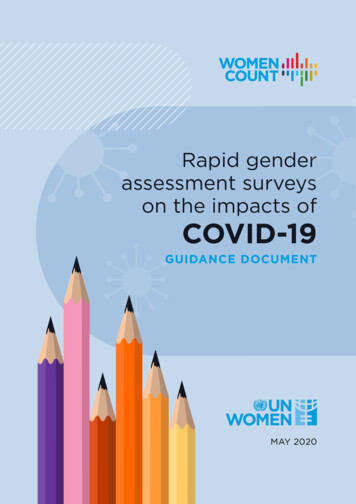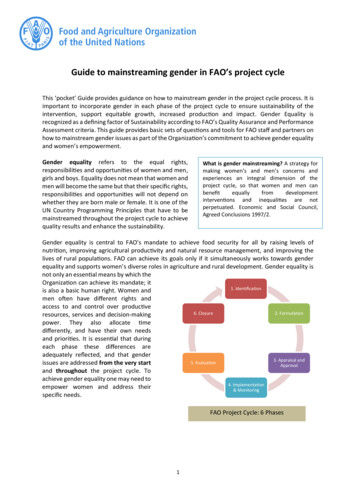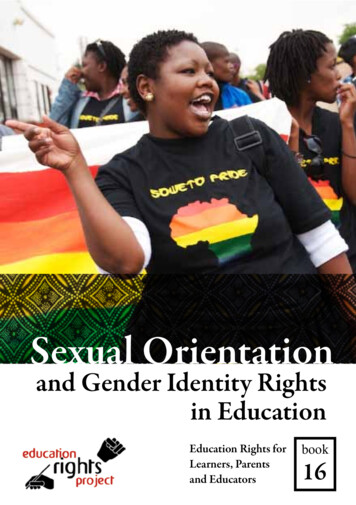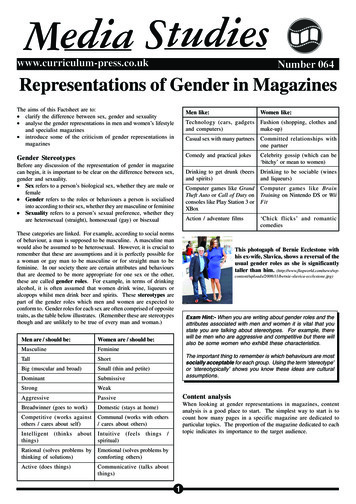
Transcription
Media Studieswww.curriculum-press.co.ukNumber 064Representations of Gender in MagazinesThe aims of this Factsheet are to: clarify the difference between sex, gender and sexuality analyse the gender representations in men and women’s lifestyleand specialist magazines introduce some of the criticism of gender representations inmagazinesMen like:Women like:Technology (cars, gadgetsand computers)Fashion (shopping, clothes andmake-up)Casual sex with many partnersCommitted relationships withone partnerGender StereotypesComedy and practical jokesCelebrity gossip (which can be‘bitchy’ or mean to women)Drinking to get drunk (beersand spirits)Drinking to be sociable (winesand liqueurs)Computer games like GrandTheft Auto or Call of Duty onconsoles like Play Station 3 orXBoxComputer games like BrainTraining on Nintendo DS or WiiFitAction / adventure films‘Chick flicks’ and romanticcomediesBefore any discussion of the representation of gender in magazinecan begin, it is important to be clear on the difference between sex,gender and sexuality. Sex refers to a person’s biological sex, whether they are male orfemale Gender refers to the roles or behaviours a person is socialisedinto according to their sex, whether they are masculine or feminine Sexuality refers to a person’s sexual preference, whether theyare heterosexual (straight), homosexual (gay) or bisexualThese categories are linked. For example, according to social normsof behaviour, a man is supposed to be masculine. A masculine manwould also be assumed to be heterosexual. However, it is crucial toremember that these are assumptions and it is perfectly possible fora woman or gay man to be masculine or for straight man to befeminine. In our society there are certain attributes and behavioursthat are deemed to be more appropriate for one sex or the other,these are called gender roles. For example, in terms of drinkingalcohol, it is often assumed that women drink wine, liqueurs oralcopops whilst men drink beer and spirits. These stereotypes arepart of the gender roles which men and women are expected toconform to. Gender roles for each sex are often comprised of oppositetraits, as the table below illustrates. (Remember these are stereotypesthough and are unlikely to be true of every man and woman.)Men are / should be:Women are / should be:MasculineFeminineTallShortBig (muscular and broad)Small (thin and veBreadwinner (goes to work)Domestic (stays at home)Competitive (works againstothers / cares about self)Communal (works with others/ cares about others)Intelligent (thinks aboutthings)Intuitive (feels things /spiritual)Rational (solves problems bythinking of solutions)Emotional (solves problems bycomforting others)Active (does things)Communicative (talks aboutthings)This photogaph of Bernie Ecclestone withhis ex-wife, Slavica, shows a reversal of theusual gender roles as she is significantlytaller than him. 008/11/bernie-slavica-ecclestone.jpg)Exam Hint:- When you are writing about gender roles and theattributes associated with men and women it is vital that youstate you are talking about stereotypes. For example, therewill be men who are aggressive and competitive but there willalso be some women who exhibit these characteristics.The important thing to remember is which behaviours are mostsocially acceptable for each group. Using the term ‘stereotype’or ‘stereotypically’ shows you know these ideas are culturalassumptions.Content analysisWhen looking at gender representations in magazines, contentanalysis is a good place to start. The simplest way to start is tocount how many pages in a specific magazine are dedicated toparticular topics. The proportion of the magazine dedicated to eachtopic indicates its importance to the target audience.1
Media Studies064. Representations of Gender in riculum-press.co.uk%10025211716975TotalCelebrities / s132383630217%100292723165This content analysis supports the gender stereotypes discussed earlier. The fact that a quarter of Nuts is dedicated to ‘women’ suggeststhat heterosexual men are interested in seeing many different women rather than focusing on one woman. Likewise, the fact that Nutsfeatures so much sport-related content indicates men’s stereotypically competitive natures. As an opposite to this, Heat shows howwomen enjoy communicating, through gossip, and are interested in fashion and looking good in their quest to find a committed relationship.The next step in content analysis is to look closely at specific parts of the content to see what it ‘says’ about representations of gender.The two magazines, Nuts and Heat, have been chosen as they are both weekly TV listings magazines and can be easily compared in termsof content and how this relates to stereotypes of gender.Target audienceDemographicsPsychographics(likes, needs anddesires)Male, aged 16 – 34, employed,skilled working class to middleclassDemographicsSocialising, watching football,playing computer games(especially action, sport anddriving games), watching filmsand using mobile phones (forInternet access as well as callsand texts)Psychographics(likes, needs anddesires)Female, aged 16 – 35, career oriented, lowermiddle class to upper middle classSocialising, going to the cinema, listening tomusic, watching TV, using the Internet, shoppingMediaplatformsPrint media – Nuts magazineBroadcast media – Nuts TV (Freeview channel 42)E-media – www.nuts.co.ukPrint media – Heat magazine, Heatworld magazineBroadcast media – Heat radioE-media – www.heatworld.com, Heat mobileNameThe name ‘Nuts’ confirms that the magazine is for men as itcan be linked to the slang term for testicles or the colloquialphrase: “it’s the nuts” to indicate something is good.The name ‘Heat’ can be linked to the celebrity content of the magazine andthe fact that the content is ‘hot gossip’ and up-to-date.Front cover(14 – 20 May 2010)TV listingsThe cover features Lucy Pinder, amodel regularly used by Nuts andother similar men’s magazines.The focus of the cover is herbreasts. This is where the lighthas been directed and it is the onlypart of her that is not partiallycovered text. The use of only herfirst name as the anchorage textsuggests the audience are familiarwith her already. The cover imageis from a shoot purposely for Nutsmagazine.The cover features two contrasting images ofAngelina Jolie. The focus is on her face in bothand the opposing emotions she is apparentlyexpressing in each. These images were not takenfor Heat but are existing photos either fromJolie’s modeling past or from the paparazzi.The ‘Innocent to Insecure’ headline suggest thisis focusing on negatives, which can be seen as‘bitchy’ or women being mean about otherwomen.(6-12 February 2010)The programmes Nuts have chosento feature conform to thestereotypes of men. Family Guyis a comedy, which links to men’senjoyment of jokes. Formula 1links to men’s love of sports andStorm World and 24 are actionpacked appealing to men’sstereotypical liking of being active.Heat includes features Dancing on Ice whichinvolves fashion (in the elaborate costumes) anddancing, which is an activity associated withwomen.The two featured films: The Devil Wears Pradaand The September Issue are both about thefashion industry2
Media Studies064. Representations of Gender in twww.curriculum-press.co.ukThe news section in Nuts features articles about:Portsmouth Football Club, a plane crash, the star of a hiphop video in her underwear, the ‘first look’ at Call of Duty7, naked celebrities and the Audi R8 GT car. This sectionof the magazine uses the stereotypes of men likingtechnology, women and sports.The news section of Heat is much smaller than Nuts and features onlytwo articles, one about Britney Spear’s depression and the other aboutJordan’s relationship with Alex Reid. Both articles rely upon women’sstereotypical interest in celebrity gossip and real life drama.The advert for Head and Shouldersin Nuts features images of two‘sexy nurses’, a clichéd sexualfantasy for men.The Head and Shoulders advert for women inHeat, focuses on how the product will give theuser ‘kissable’ hair, indicated by the lipimprints.The suggestion is that using Headand Shoulders will make a mansmell so good women will want tokiss him, as one nurse is doing inthe image.Both adverts hinge on the idea that using Headand Shoulders will make the opposite sex wantto kiss you but the female version is more aboutlooking good too.The horror genre is stereotypicallymasculine so the advert for theremake of Nightmare on ElmStreet fits with this stereotype.There are no film adverts in Heat but there areseveral adverts for TV programmes. This couldbe seen to refer to women being linked to thehome.The inclusion of an advert for afilm at the cinema also links to menenjoying socializing with friendsand having fun.The Vampire Diaries is also in the horror genrebut the focus of this advert is on love andrelationships rather than death and horror.The food adverts in Heat are mainly forchocolate-based products.There are very few adverts forfood in Nuts compared to Heat.Food advertIn this advert, the association of women withchocolate is coupled with the stereotypes thatwomen care about their looks, especially theirweight. The calorie content displayed is a clearsign of this.This links to the stereotype thatmen are not domestic and have awoman to prepare their food. Inthis advert for Extreme Pringles,the emphasis is on being braveenough to try them and taking onthe challenge.Nuts logo from http://en.academic.ru/pictures/enwiki/78/Nuts logo.jpgHeat logo from http://i-mode.o2.co.uk/images/logo heat.jpgAll other Nuts images scanned from 14 – 20 May issue and all other Heat images scanned from 6 – 12 February issueActivityUsing the Nuts and Heat content analysis as a basis, conduct your own content analysis of two magazines, one targeted at womenand one at men. The following pairings could be used: Zoo and More Cosmopolitan and GQExam Hint:- Examiners will want to see that you have engaged with your research into magazines so make sure you use recentissues as examples. You will also need to be very familiar with the contents of your chosen texts. You should look closely at the typesof products advertised, the subject matter of the articles and the portrayals of men and women in the images.3
Media Studies064. Representations of Gender in Magazineswww.curriculum-press.co.ukSexual relationshipsRelation- -ships Friends Body Image / DietsFashion / Make-upSemi-naked menCelebrities / GossipReal Life StoriesHoroscopes / TarotCooking / RecipesCareers / Success WeddingsHoliday / TravelCrafts25 - 4025 - 45 Fitness / Health Fashion / Grooming Sport Science / Research Cooking / Recipes Careers / Success Problem Page Letters from Readers Competitions Fashion Letters from ReadersFictionGlamour Problem PageCompetitions / Puzzles16 – 35WomenSexualFamilyMen’s Health(March 2010)55 GQ(January 2010)30 – 50Front(July 2010)Woman’s Weekly(13 April 2010)16 – 35Yours(20 April – 3 May2010)Cosmopolitan(June 2010)The content topics identified in Heat are not exhaustive for women’s magazines. In fact, Heat is very limited in terms of its content as itfocuses so heavily on celebrity gossip. There are many magazines available for women of all ages but the content of them all is remarkablesimilar. In contrast, magazines for men across a similar age range offer a much more diverse selection of content. Technology Comedy Holiday / Travel Fiction Celebrity interviews Entertainment These three examples, Cosmopolitan, Woman’s Weekly and Yours,span the age range of magazines for women but they all containmuch the same content.Of the three magazines analysed, Front, GQ and Men’s Health, theonly content that was evident in all three magazines was adviceabout heterosexual relationships and fashion.The only significant differences are the lack of content related tosexual relationships (including images of semi-naked men) and careersin magazines for older women. It could be assumed that this isbecause, stereotypically, women will be expected to be ‘settled down’with a family in their 30s so have no need for advice on how to get aman or get a fulfilling job.This suggests that the behaviours considered acceptable for menare much more wide-ranging than for women. For example, bothGQ and Men’s Health include articles on cooking but none of thewomen’s magazines include content about technology or science.Similarly, the inclusion of crafts, such as knitting, and fiction inmagazines for older women links to the idea that the women will be athome and in need of leisure pursuits which fit in around theirdomestic life, such as reading a short story with a cup of tea.4
Media Studies064. Representations of Gender in Magazineswww.curriculum-press.co.ukRepresentation of gender in specialist magazinesThe magazines that have been discussed so far are examples of lifestyle magazines as they feature advice on how to live your life (whatclothes to wear, how to behave in relationships etc.) However, there are also examples of specialist magazines, which are about oneparticular topic (usually a hobby or special interest), that are also heavily reliant upon gender stereotypes.Representation of masculinity in specialist magazinesBig Carp(Vol. 28 Issue 164)Fast Bikes(May 2010)Big, muscular and strong – in order to land a big fish or to control a power motorcycle,a man would need to be physically strong, which is shown to be a desirable trait in thesemagazines.Competitive – there is an element of being better than others in both these sports:catching the biggest fish or driving the fastest.Dominant – connected to the idea of being competitiv
Before any discussion of the representation of gender in magazine can begin, it is important to be clear on the difference between sex, gender and sexuality. Sex refers to a person’s biological sex, whether they are male or female Gender refers to the roles or behaviours a person is socialised into according to their sex, whether they are masculine or feminine Sexuality refers to .




